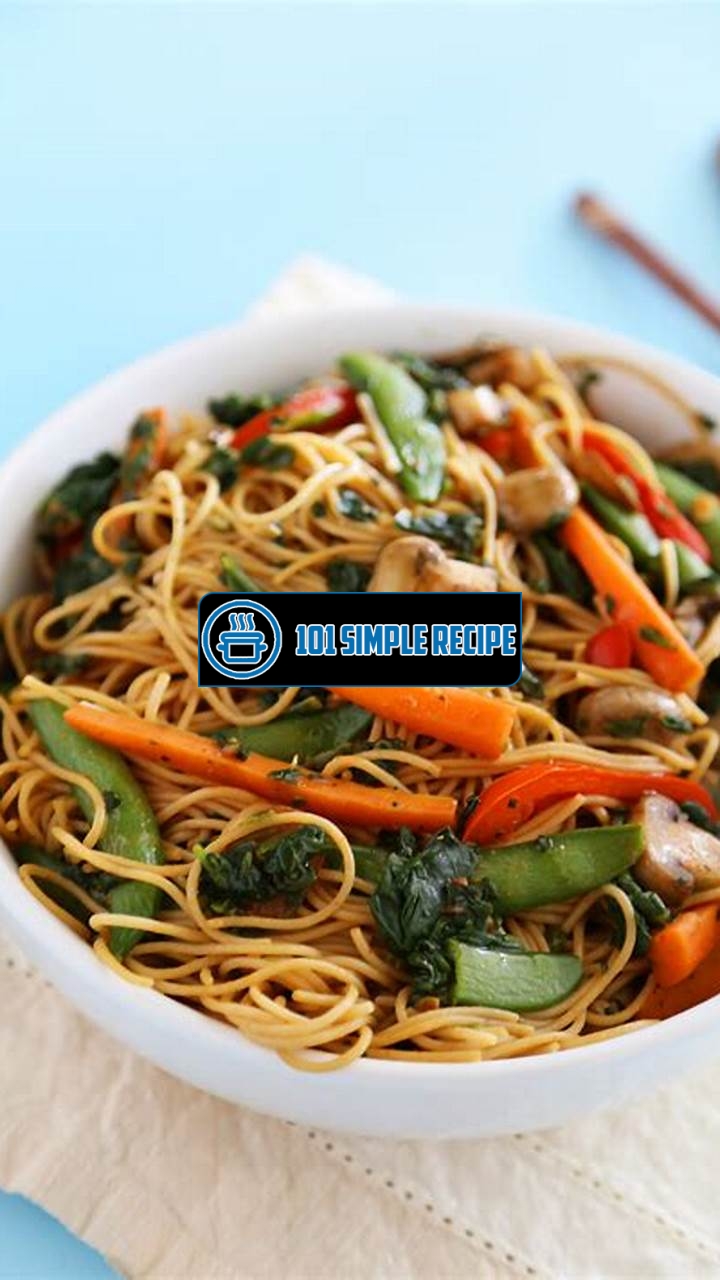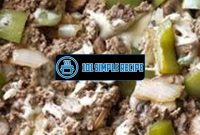If you’re tired of ordering takeout and want to try your hand at creating a delectable vegetarian dish at home, look no further than this recipe for delicious vegetarian lo mein. This classic Chinese dish is packed with flavor and sure to satisfy your cravings. With a few simple ingredients and some easy steps, you’ll be able to whip up a tasty and wholesome meal in no time. So put on your apron, grab your wok, and get ready to impress your taste buds with this mouthwatering vegetarian lo mein recipe.

The Origins of Vegetarian Lo Mein
Explore the rich history and cultural significance of vegetarian lo mein.
Ancient Roots: The Beginnings of Lo Mein
Vegetarian lo mein, a popular Chinese dish, traces its origins back to ancient times. Lo mein, meaning “tossed noodles” in Cantonese, has been a staple in Chinese cuisine for centuries. This versatile dish was first created during the Han Dynasty in China, and its popularity spread throughout the country over the years.
During this time, lo mein was typically made with wheat flour noodles, eggs, and various vegetables. It served as a satisfying and nourishing meal for the farmers and workers who needed a quick and hearty meal to fuel their bodies. The traditional lo mein was not vegetarian, as it usually included meat or seafood as well.
Fun fact: The Chinese believed that eating long noodles, such as lo mein, symbolized a long and prosperous life.
The Transformation: From Traditional to Vegetarian
As vegetarianism gained popularity worldwide, the demand for meat-free versions of classic dishes also increased. This led to the transformation of traditional lo mein into a vegetarian delight. With a few simple substitutions, lo mein became accessible to a wider range of diners.
The meat or seafood typically found in lo mein was replaced with a medley of fresh vegetables, such as carrots, broccoli, mushrooms, and bell peppers. These colorful additions not only provided a burst of flavors but also enhanced the visual appeal of the dish. Additionally, tofu or seitan can be added to the vegetarian lo mein to provide a protein-rich component.
Important note: To infuse the dish with delicious flavors, vegetarian lo mein is often seasoned with soy sauce, garlic, ginger, and other spices.
Influences and Variations: Regional Flair in Vegetarian Lo Mein
Vegetarian lo mein has also been influenced by regional flavors and cooking styles, resulting in a variety of delicious variations. Different regions in China have their unique ways of preparing and seasoning lo mein, showcasing the diversity of Chinese cuisine.
In Sichuan province, for example, the vegetarian lo mein is known for its spicy and numbing flavor profile. The noodles are stir-fried with chili oil and Sichuan peppercorns, creating a fiery and addictive dish. In contrast, the vegetarian lo mein in Shanghai is often served with a light and savory sauce, highlighting the delicate flavors of the noodles and vegetables.
Outside of China, vegetarian lo mein has gained popularity in many other countries, including the United States. It has become a go-to choice for individuals looking for a vegetarian or vegan option at Chinese restaurants.
Pro tip: Experiment with different vegetables and sauces to create your own unique version of vegetarian lo mein at home!
In conclusion, vegetarian lo mein has a fascinating history and has evolved over the centuries to cater to different dietary preferences and regional tastes. Whether enjoyed in China or abroad, this satisfying and flavorful dish continues to captivate the taste buds of people worldwide. So why not give it a try and embark on a culinary adventure with vegetarian lo mein!
The Key Ingredients of Vegetarian Lo Mein
Discover the essential components that give vegetarian lo mein its unique flavors and textures.
The Noodles: Choosing the Perfect Base
When it comes to vegetarian lo mein, the noodles are the foundation of this delicious dish. The type of noodles you choose can greatly impact the overall taste and texture. The most common noodles used in lo mein are wheat noodles or egg noodles. These noodles are soft and have a slightly chewy texture, which pairs perfectly with the other ingredients.
For a healthier option, you can opt for whole wheat noodles or even rice noodles. Whole wheat noodles add a nutty flavor to the dish and are packed with fiber. Rice noodles, on the other hand, have a light and delicate texture that adds a unique touch to the lo mein.
Whether you decide to use wheat, egg, whole wheat, or rice noodles, always follow the cooking instructions on the packaging to achieve the perfect texture. Overcooking the noodles can result in a mushy and unappetizing dish, so make sure to keep an eye on them while they cook.
The Vegetables: Exploring a World of Options
One of the beauties of vegetarian lo mein is the variety of vegetables you can use to create a colorful and flavorful dish. From crunchy bell peppers to tender broccoli florets, the options are endless.
Here are some popular vegetables often found in vegetarian lo mein:
- Carrots: Carrots add a touch of sweetness and vibrant color to the dish. They can be thinly sliced or julienned to create a beautiful visual appeal.
- Snap Peas: These crisp and fresh peas provide a satisfying crunch to each bite. They add a burst of green color and a hint of sweetness to the dish as well.
- Mushrooms: Whether you choose shiitake, cremini, or oyster mushrooms, they all bring a rich umami flavor to the lo mein. Slice them thinly or keep them whole for a meaty texture.
- Bean Sprouts: Bean sprouts are a classic addition to any stir-fry dish. These crunchy sprouts offer a mild and delicate taste, adding a refreshing element to the lo mein.
Feel free to experiment with other vegetables such as bok choy, onions, baby corn, or snow peas, depending on your personal preference. The key is to have a good balance of colors, textures, and flavors to make your vegetarian lo mein truly irresistible.
The Sauces and Seasonings: Adding Depth and Flavor
The sauces and seasonings are what bring the vegetarian lo mein to life, elevating it from a simple stir-fry to a complex and flavorful dish. The combination of soy sauce, sesame oil, garlic, and ginger is a classic base for the sauce.
To add an extra kick to your lo mein, you can incorporate other sauces and seasonings such as:
- Hoisin sauce: This sweet and savory sauce adds a rich and tangy flavor to the dish. It pairs well with the other ingredients and gives the lo mein an irresistible glaze.
- Rice vinegar: A splash of rice vinegar can brighten up the flavors of the lo mein. Its mild acidity balances out the richness of the sauce and enhances the overall taste.
- Chili paste: If you like a bit of heat, adding chili paste or sriracha sauce can give your lo mein a spicy kick. Adjust the amount according to your taste preferences.
- Green onions: Finely sliced green onions add a fresh and aromatic touch to the dish. Sprinkle them on top of the lo mein before serving for an extra burst of flavor.
Remember to taste and adjust the seasonings as you go. Everyone’s palate is different, so feel free to add more or less of each ingredient to suit your taste.
With the right noodles, an array of colorful vegetables, and a combination of flavorful sauces and seasonings, you can easily create a delicious vegetarian lo mein at home. Get creative, customize the dish to your liking, and enjoy this satisfying and flavorful meal with friends and family!
Try different vegetables and sauces to create your own unique variation of vegetarian lo mein!
The Health Benefits of Vegetarian Lo Mein
Discover the wonderful health benefits of vegetarian lo mein, an incredibly nutritious and wholesome dish that can be a delightful addition to your diet. Packed with essential nutrients and bursting with vibrant flavors, this Chinese-inspired noodle dish is a fantastic choice for both vegetarians and meat-eaters alike.
Protein-Packed Power: The Role of Tofu and Seitan
One of the key components that make vegetarian lo mein a nutritional powerhouse is the presence of protein-rich ingredients like tofu and seitan.
Tofu, made from soybeans, is an excellent plant-based source of protein. It contains all nine essential amino acids that your body needs for optimal function and muscle growth. Furthermore, tofu is low in saturated fat, making it a heart-healthy protein option.
Seitan, also known as wheat gluten, is another fantastic protein source commonly found in vegetarian lo mein. With a robust and chewy texture, seitan can easily substitute for meat in various dishes. It’s low in fat and cholesterol-free, making it an ideal choice for those looking to reduce their meat consumption without sacrificing protein intake.
Fiber and Vitamins: The Abundance of Vegetables
The abundance of vegetables in vegetarian lo mein adds a delightful crunch and a generous serving of fiber and essential vitamins.
Carrots, bell peppers, mushrooms, and broccoli are fantastic additions that not only enhance the flavor but also offer a myriad of health benefits. Carrots, in particular, are rich in beta-carotene, a potent antioxidant that promotes good vision and overall eye health. Meanwhile, bell peppers are an excellent source of vitamin C, which boosts the immune system and promotes collagen production for healthy skin.
Additionally, mushrooms contribute to the dish by providing essential nutrients like potassium and copper, which are important for proper nerve function and a healthy metabolism. Broccoli, packed with vitamins K and C, is known for its cancer-fighting properties and may help reduce the risk of heart disease.
Low Fat, High Flavor: The Benefits of Lighter Sauces
One of the significant advantages of vegetarian lo mein is its lower fat content, thanks to the use of lighter sauces.
Traditional lo mein dishes typically rely on heavy sauces that are high in fat and sodium. However, by opting for lighter sauces made with ingredients such as soy sauce, hoisin sauce, and sesame oil, you can enjoy the dish guilt-free while still relishing the rich flavors.
Lighter sauces not only reduce the caloric content but also enhance the natural flavors of the vegetables and proteins. The result is a delicious and satisfying meal that doesn’t compromise your health goals.
Next time you’re craving a delicious and nutritious meal, consider making vegetarian lo mein at home. With its protein-packed tofu or seitan, fiber-rich vegetables, and flavorful lighter sauces, this dish will not only satisfy your taste buds but also provide a nourishing boost to your overall well-being. Enjoy the journey of exploring different flavors and experimenting with various vegetable combinations to create your perfect vegetarian lo mein dish!
If you’re interested in other Asian noodle dishes, you might enjoy our ramen noodle recipes.
The Culinary Techniques Behind Vegetarian Lo Mein
Uncover the secrets to creating the perfect vegetarian lo mein at home. With the right culinary techniques, you can enjoy a delicious and satisfying meal that is both healthy and flavorful. Whether you are a seasoned chef or a beginner in the kitchen, these tips and tricks will help you create a mouthwatering vegetarian lo mein that will impress your family and friends.
Mastering the Stir-Fry: Achieving the Perfect Texture
When it comes to cooking vegetarian lo mein, mastering the stir-fry technique is essential for achieving the perfect texture. The key is to cook the vegetables quickly over high heat, ensuring they retain their crispness and vibrant colors. Start by heating your wok or skillet until it is hot, then add a small amount of oil and your favorite vegetables. Remember to cut the vegetables into uniform sizes to ensure even cooking.
As you stir-fry the vegetables, toss them continuously to prevent them from sticking to the pan. You can use a wooden spoon or a pair of tongs to gently toss the vegetables. The goal is to cook them until they are just tender, but still slightly crunchy. This will give your vegetarian lo mein a delightful texture that is both satisfying and enjoyable to eat.
Important: When stir-frying your vegetables, it is crucial to avoid overcooking them. Overcooked vegetables can become mushy and lose their nutritional value. So keep a close eye on them and remove them from the heat as soon as they are done.
Balancing Flavors: Understanding Umami and Sweet-Savory Combinations
Creating a delicious vegetarian lo mein goes beyond just the vegetables. It’s important to balance the flavors to achieve a harmonious and satisfying dish. One key element to consider is umami, the fifth taste that adds depth and richness to your meal. To enhance the umami in your vegetarian lo mein, you can incorporate ingredients such as soy sauce, mushrooms, or fermented bean paste.
In addition to umami, sweet and savory combinations can elevate the flavors of your vegetarian lo mein. You can achieve this by adding a touch of sweetness through ingredients like hoisin sauce or mirin. The sweet-savory combination enhances the overall taste of the dish and creates a more complex flavor profile.
Note: Experimenting with different flavor combinations is part of the fun of cooking. Don’t be afraid to try new ingredients and adjust the recipe to suit your taste preferences. ✨
Enhancing Presentation: Techniques for Vibrant and Fresh-looking Lo Mein
They say we eat with our eyes first, and the same goes for vegetarian lo mein. To enhance the presentation of your dish and make it look more vibrant and fresh, there are a few techniques you can try. First, consider using a variety of colorful vegetables, such as carrots, bell peppers, and snow peas. The combination of different hues will make your dish visually appealing.
Another technique to enhance the presentation is to garnish your vegetarian lo mein with fresh herbs, such as cilantro or green onions. This adds a pop of green color and a burst of freshness to the dish. You can also sprinkle some toasted sesame seeds or crushed peanuts on top for added texture and flavor.
Important: Remember that presentation is not just about how the dish looks on the plate but also how it is served. Consider using stylish bowls or plates and arranging the noodles and vegetables in an aesthetically pleasing way. This will make your vegetarian lo mein look more appetizing and encourage your guests to dig in.
By mastering the culinary techniques behind vegetarian lo mein, you can create a delicious and visually appealing dish that will impress your family and friends. Don’t be afraid to unleash your creativity and experiment with different ingredients and flavors. Enjoy the process of cooking and savor the flavors of your homemade vegetarian lo mein. Bon appétit!
If you’re looking for more delicious vegetarian recipes, check out our vegetarian recipes collection!
Exploring Vegetarian Lo Mein Variations
Dive into the world of creative twists and unique variations of vegetarian lo mein. Here are some exciting ways to elevate this classic dish and tantalize your taste buds.
Fusion Flavors: Blending Traditional Asian Cuisine with Western Influences
Explore the exciting fusion of traditional Asian flavors with a Western twist. Incorporate ingredients and techniques from both culinary worlds to create a unique and delicious vegetarian lo mein.
Combine the umami-rich flavors of soy sauce, ginger, and sesame oil with Western ingredients such as sun-dried tomatoes or roasted red peppers. The result is a fusion masterpiece that combines the best of both worlds.
Add a touch of sweetness with caramelized onions or maple syrup. This unexpected twist adds depth and complexity to the dish, taking it to a whole new level.
️ For a spicy kick, experiment with Asian-inspired chili sauces like sriracha or gochujang. These fiery additions will awaken your taste buds and give your vegetarian lo mein an extra layer of flavor.
Spice It Up: Incorporating Heat with Chili and Pepper
️ If you love a little heat, there are countless ways to incorporate chili and pepper into your vegetarian lo mein.
️ Amp up the spiciness by adding fresh chili peppers or crushed red pepper flakes. Adjust the amount according to your preference to achieve the perfect balance of heat.
️ For a smoky and robust flavor, try using chipotle peppers or smoked paprika. These ingredients add a unique depth to the dish and create a delightful contrast to the other flavors.
️ Roasted red bell peppers or sun-dried tomatoes can also bring a touch of sweetness and tanginess to the dish, balancing out the heat from the chili and pepper.
Vegetarian Protein Powerhouses: Exploring Beyond Tofu and Seitan
While tofu and seitan are popular vegetarian choices for protein in lo mein, there are other options to explore to amp up the protein content of your dish.
Add nutrient-rich vegetables like broccoli, mushrooms, and edamame to increase the protein content while adding texture and flavor.
Include lentils or chickpeas for a hearty and satisfying vegetarian lo mein. These legumes are packed with protein and offer a unique taste and texture to the dish.
Don’t forget about grains and greens! Quinoa, brown rice, or leafy greens such as spinach or kale can be excellent sources of plant-based protein.
Experiment with different combinations of plant-based proteins to find your favorite variation of vegetarian lo mein. The possibilities are endless!
For a quick and easy stir-fry option, try our stir-fry recipes collection!
Thank you for taking the time to read about vegetarian lo mein. We hope you found this article helpful in your quest for delicious and healthy meals. If you’re looking for more vegetarian recipes or want to explore other cuisines, be sure to bookmark our site and visit again later. Our team is constantly adding new and exciting recipes that are sure to satisfy your taste buds. Whether you’re a seasoned vegetarian or just looking to incorporate more plant-based meals into your diet, we’ve got you covered! Happy cooking!
Frequently Asked Questions
Here are some frequently asked questions about vegetarian lo mein:
| No. | Questions | Answers |
|---|---|---|
| 1. | Is vegetarian lo mein a healthy option? | Yes, vegetarian lo mein can be a healthy option as it is packed with vegetables and provides a good source of nutrients. However, it is important to watch the amount of oil and sodium used in the recipe. |
| 2. | Can I customize the vegetables in vegetarian lo mein? | Absolutely! You can customize the vegetables in vegetarian lo mein based on your preferences or what you have on hand. Some popular options include broccoli, bell peppers, carrots, and mushrooms. |
| 3. | Is lo mein gluten-free? | Traditional lo mein is made with wheat noodles, which contain gluten. However, you can easily make gluten-free lo mein by using gluten-free noodles or substituting the noodles with zucchini noodles or spaghetti squash. |
| 4. | Can I add protein to vegetarian lo mein? | Yes, you can add protein to vegetarian lo mein by incorporating tofu, tempeh, edamame, or even cooked chickpeas. These additions will not only enhance the flavor but also provide a good source of plant-based protein. |
| 5. | Can I make vegetarian lo mein spicy? | Definitely! If you enjoy spicy food, you can add chili flakes, sriracha sauce, or sliced chili peppers to your vegetarian lo mein. Just adjust the amount of spice to your personal preference. |
| 6. | How long does it take to cook vegetarian lo mein? | The cooking time for vegetarian lo mein can vary depending on the recipe and the type of noodles used. However, most recipes can be prepared in around 20-30 minutes. |
Closing Thoughts
We hope this article has inspired you to try making vegetarian lo mein at home. With its vibrant colors, flavorful ingredients, and satisfying taste, vegetarian lo mein is a versatile and delicious dish that can be enjoyed by everyone. Remember to explore different variations and experiment with your favorite vegetables and seasonings to create a personalized lo mein experience. Don’t forget to visit us again for more exciting recipes and culinary inspiration. Happy cooking!
Jump to Recipe
Vegetarian Lo Mein

A flavorful and healthy vegetarian lo mein recipe packed with fresh vegetables and savory sauce.
- 8 ounces lo mein noodles
- 2 tablespoons soy sauce
- 2 tablespoons oyster sauce
- 1 tablespoon sesame oil
- 1/4 cup vegetable broth
- 1 tablespoon cornstarch
- 1 tablespoon vegetable oil
- 3 cloves garlic (minced)
- 1 small onion (thinly sliced)
- 1 cup snap peas
- 1 cup shredded cabbage
- 1 medium carrot (julienned)
- 1/2 cup sliced mushrooms
- 1/4 cup sliced green onions
- 1/4 teaspoon red pepper flakes (optional)
- Salt and pepper (to taste)
- Bring a large pot of water to a boil. Cook the lo mein noodles according to the package instructions. Drain and rinse with cold water.
- In a small bowl, whisk together soy sauce, oyster sauce, sesame oil, vegetable broth, and cornstarch. Set aside.
- Heat vegetable oil in a large pan or wok over medium-high heat. Add garlic and onion, and sauté until fragrant. Add snap peas, cabbage, carrot, and mushrooms. Stir-fry for 3-4 minutes, or until the vegetables are tender-crisp.
- Add the cooked noodles to the pan with the vegetables. Pour the sauce over the top and toss to coat everything evenly. Cook for an additional 2-3 minutes, or until heated through.
- Add sliced green onions, red pepper flakes (if using), and season with salt and pepper to taste. Stir well and remove from heat. Serve hot and enjoy!






